Apple PowerBook G4 User Manual

PowerBook G4 15-inch
User’s Guide
Includes setup, expansion, and troubleshooting information for your PowerBook G4 computer
K Apple Computer, Inc.
© 2005 Apple Computer, Inc. All rights reserved.
Under the copyright laws, this manual may not be copied, in whole or in part, without the written consent of Apple.
The Apple logo is a trademark of Apple Computer, Inc., registered in the U.S. and other countries. Use of the “keyboard” Apple logo (Option-Shift-K) for commercial purposes without the prior written consent of Apple may constitute trademark infringement and unfair competition in violation of federal and state laws.
Every effort has been made to ensure that the information in this manual is accurate. Apple is not responsible for printing or clerical errors.
Apple
1 Infinite Loop
Cupertino, CA 95014-2084 408-996-1010 www.apple.com
Apple, the Apple logo, AirPort, AppleTalk, Final Cut Pro, FireWire, iCal, iDVD, iLife, iMovie, iPhoto, iPod, iTunes, Mac, Macintosh, Mac OS, and PowerBook are trademarks of Apple Computer, Inc., registered in the U.S. and other countries.
AirPort Express, Exposé, FileVault, Finder, the FireWire logo, iSight, Safari, Spotlight, SuperDrive, Tiger, and Xcode are trademarks of Apple Computer, Inc.
AppleCare, Apple Store, and iTunes Music Store are service marks of Apple Computer, Inc., registered in the U.S. and other countries.
.Mac is a service mark of Apple Computer, Inc.
ENERGY STAR® is a U.S. registered trademark.
The Bluetooth® word mark and logos are owned by the Bluetooth SIG, Inc. and any use of such marks by Apple Computer, Inc. is under license.
PowerPC is a trademark of International Business Machines Corporation, used under license therefrom.
Other company and product names mentioned herein are trademarks of their respective companies. Mention of third-party products is for informational purposes only and constitutes neither an endorsement nor a recommendation. Apple assumes no responsibility with regard to the performance or use of these products.
The product described in this manual incorporates copyright protection technology that is protected by method claims of certain U.S. patents and other intellectual property rights owned by Macrovision Corporation and other rights owners. Use of this copyright protection technology must be authorized by Macrovision Corporation and is intended for home and other limited viewing uses only unless otherwise authorized by Macrovision Corporation. Reverse engineering or disassembly is prohibited.
Apparatus Claims of U.S. Patent Nos. 4,631,603, 4,577,216, 4,819,098 and 4,907,093 licensed for limited viewing uses only.
Simultaneously published in the United States and Canada.

Contents
Chapter 1 |
5 |
Getting Started |
|
6 |
Setting Up Your PowerBook |
|
12 |
Basic Features of Your PowerBook |
|
14 |
Additional Features of Your PowerBook |
|
16 |
Putting Your PowerBook to Sleep or Shutting It Down |
|
17 |
Calibrating Your Battery |
|
18 |
Getting More Information |
Chapter 2 |
19 |
Getting to Know Your PowerBook |
|
20 |
Adjusting Your Display |
|
21 |
Using Your Power Adapter |
|
22 |
Using the Trackpad |
|
23 |
Using the Keyboard |
|
24 |
Using a Mouse |
|
24 |
Learning About Mac OS X |
|
25 |
Customizing Your Desktop and Setting Your Preferences |
|
26 |
Getting Answers Using Mac Help |
|
26 |
Using Applications |
|
27 |
When an Application Does Not Respond |
|
27 |
Connecting to a Network |
|
27 |
Using the Internet |
|
28 |
Keeping Your Software Up to Date |
|
28 |
Connecting to a Printer |
|
30 |
Playing a CD and Connecting Headphones |
|
30 |
Connecting a Camera or Other FireWire or USB Device |
|
30 |
Transferring Files to Another Computer |
Chapter 3 |
33 |
Using Your PowerBook |
|
34 |
Using Universal Serial Bus (USB) Devices |
|
36 |
Connecting With FireWire |
|
38 |
Using PC Cards |
|
39 |
Understanding AirPort Extreme Wireless Networking |
|
40 |
Using Bluetooth Wireless Technology |
3
|
43 |
Connecting With Ethernet (10/100/1000Base-T) |
|
44 |
Using Your Modem |
|
44 |
Using External Video Support (DVI, VGA, and S-Video) |
|
47 |
Connecting Speakers and Other Audio Devices |
|
47 |
Using Your SuperDrive |
|
51 |
Understanding Sudden Motion Sensor |
|
51 |
Using Your Battery |
|
55 |
Securing Your PowerBook |
Chapter 4 |
57 |
Adding Memory to Your PowerBook |
|
58 |
Installing Additional Memory |
|
62 |
Making Sure Your PowerBook Recognizes the New Memory |
Chapter 5 |
63 |
Troubleshooting |
|
63 |
Problems That Prevent You From Using Your Computer |
|
65 |
Other Problems |
|
67 |
Reinstalling the Software That Came With Your Computer |
|
69 |
Using Apple Hardware Test |
|
69 |
Installing Xcode Tools |
|
69 |
Locating Your Product Serial Number |
Appendix A |
71 |
Specifications |
Appendix B |
73 |
Safety, Use, and Care Information |
|
73 |
Safety Instructions for Setting Up and Using Your Computer |
|
74 |
Using Your PowerBook |
|
75 |
Understanding General Safety Instructions |
|
76 |
Handling the Battery |
|
76 |
Avoiding Hearing Damage |
|
77 |
Understanding Ergonomics |
|
78 |
Apple and the Environment |
Appendix C |
79 |
Connecting to the Internet |
|
81 |
Gathering the Information You Need |
|
82 |
Entering Your Information |
|
82 |
Connecting With a Dial-Up Modem |
|
84 |
Connecting With DSL, Cable Modem, or LAN |
|
89 |
Configuring Your AirPort Extreme Wireless Connection |
|
93 |
Troubleshooting Your Connection |
Appendix D |
95 |
Top Ten Questions |
|
99 |
Communications Regulation Information |
Index |
105 |
|
4 |
Contents |
|
|
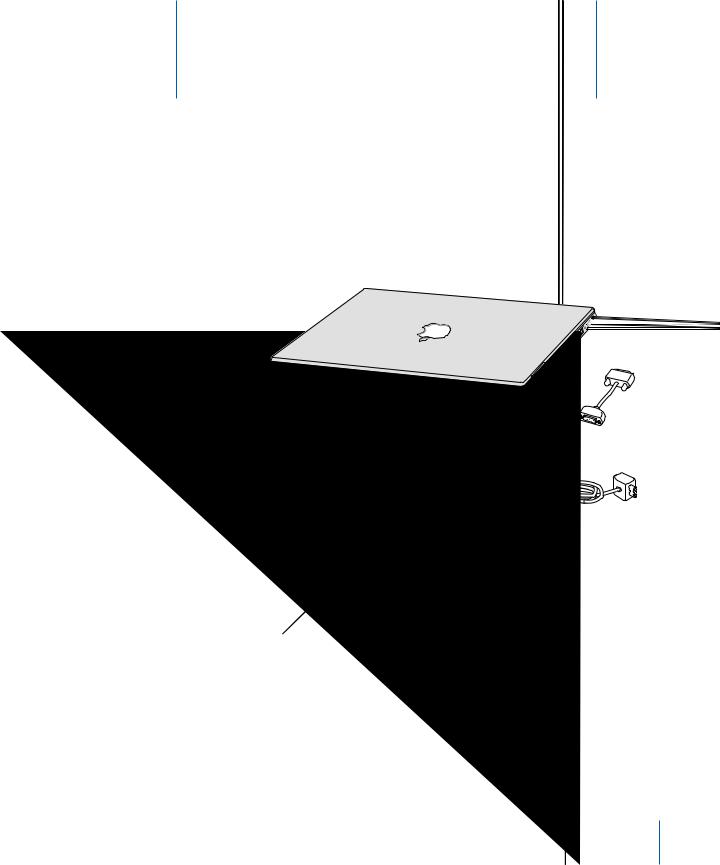
Getting Started |
1 |
|
Your PowerBook is a full-featured notebook computer.
Your PowerBook includes the following components:
S-video-to-composite adapter |
|
DVI-to-VGA adapter |
|
AC plug |
|
Phone cord |
Power adapter |
AC cord |
Important: Read all the installation instructions and safety information (see “Safety, Use, and Care Information” on page 73) carefully before you plug your computer in to a wall socket.
5

Setting Up Your PowerBook
Your PowerBook is designed so that you can set it up quickly and start using it right away. The following pages take you through the setup process, including these tasks:
ÂPlugging in the power adapter
ÂConnecting the cables
ÂTurning on your PowerBook
ÂConfiguring a user account and other settings using Setup Assistant
Step 1: Plug In the Power Adapter
If there is protective film around the power adapter, remove it before setting up your PowerBook.
mInsert the AC plug of your power adapter into an outlet and the power adapter plug into the PowerBook power adapter port.
AC plug
Important: Make sure the AC plug is fully inserted into the power adapter and the electrical prongs on your AC plug are in their completely extended position before you plug the adapter in to the outlet.
To extend the reach of your power adapter, you can attach the AC cord. First, pull up on the AC plug to remove it from the adapter, and then attach the included AC cord to the adapter. Insert the other end into a wall outlet. For an illustration, see page 21.
6 |
Chapter 1 Getting Started |
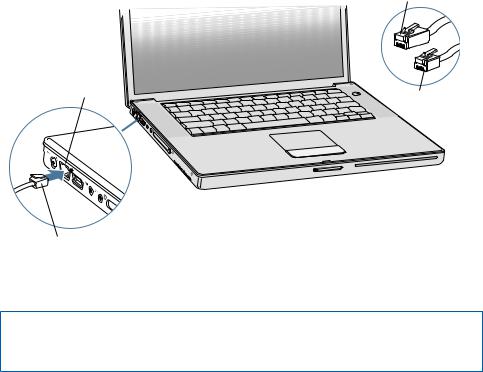
Step 2: Connect Your Cables
Next, for an Internet connection, connect your PowerBook to a phone line, DSL modem, cable modem, or Ethernet network. If you’re connecting to a wireless AirPort Extreme 802.11b or 802.11g network, you don’t need cables.
To connect to a phone line:
mConnect the phone cord from a wall jack to the internal modem port for a dial-up connection.
W Internal modem port
®
Ethernet cord
Telephone cord
Telephone cord
Make sure you connect the internal modem to an analog phone line—the kind used typically in homes.
Warning: Do not connect a digital phone line to the modem; the wrong type of line could damage the modem. Contact your telephone service provider if you are unsure whether you have a digital phone line.
For more information about your modem, see “Using Your Modem” on page 44.
For information about other types of connections, see Appendix C,“Connecting to the Internet,” on page 79.
Chapter 1 Getting Started |
7 |
|
|

To connect to a DSL or cable modem or an Ethernet network:
mConnect the cable to your DSL or cable modem as shown in the modem instructions, or connect the Ethernet cord to the Ethernet hub or outlet. Then connect the other end of the cord to the computer’s Ethernet port.
Step 3: Turn On Your PowerBook
1To turn on the PowerBook, press the power button (®).
When you turn on the computer, you should see the sleep indicator light turn on (and stay on), and you should hear a tone.
8 |
Chapter 1 Getting Started |
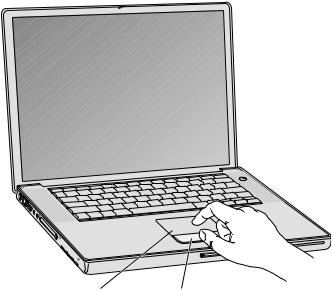
It takes the PowerBook a few moments to start up. After it starts up, the sleep indicator light turns off, and Setup Assistant opens automatically.
Note: To start up your PowerBook, press the power button (®) only once briefly (up to 1 second). Do not continue to hold down or press the power button after the startup tone or you might cause the computer to shut down again.
2Use your PowerBook trackpad to select and move items on the screen, just like you use a mouse with a desktop computer.
 To move the arrow pointer on the screen, slide your finger across the trackpad.
Important: Use only one finger on the trackpad to move the pointer. The trackpad is designed to allow scrolling when you use two adjoining fingers and the scrolling feature is turned on. See “Using the Trackpad” on page 22 for more information.
 To select, click, or double-click an item on the screen, use the trackpad button.
®
Trackpad |
Trackpad button |
Chapter 1 Getting Started |
9 |
|
|

Problems Turning On the Computer?
Nothing happens when you press the power button (®).
ÂThe battery might be drained. Make sure that you plugged the power adapter firmly in to both the computer and a power source. The plug should light when you plug it in to the computer.
ÂIf the computer still doesn’t start up, see “Problems That Prevent You From Using Your Computer” on page 63.
You see a picture of a disk or a folder with a blinking question mark.
ÂThis icon usually means that the computer can’t find the system software on the hard disk or any disks attached to the computer. Try restarting. Hold down the power button (®) for 4 to 5 seconds until the computer turns off. Then press the power button again. If the problem persists, you might need to reinstall the system software. See “Reinstalling the Software That Came With Your Computer” on
page 67.
Step 4: Configuring With Setup Assistant
The first time you turn on your computer, Setup Assistant starts. Setup Assistant helps you enter your Internet and email information and set up a user on your computer.
If you already have a Mac, Setup Assistant can help you automatically transfer files, applications, and other information from your previous Mac to your new PowerBook.
To transfer information, make sure:
ÂYour other Mac has built-in FireWire and supports FireWire Target Disk Mode
ÂYour other Mac has Mac OS X v10.4 or later installed
ÂYou have a standard 6-pin to 6-pin FireWire cable
Setup Assistant takes you through the process of transferring your information—just follow the onscreen instructions. Transferring information to your PowerBook does not affect the information on your other Mac. (If you set up partitions on the new PowerBook, all information from the other Mac will be transferred to one partition.)
10 |
Chapter 1 Getting Started |
|
|
Using Setup Assistant, you can transfer:
ÂUser accounts, including preferences and email
ÂNetwork settings, so your new PowerBook is automatically set up to work with the same network settings as your other Mac
ÂFiles and folders on the hard disk and partitions. This gives you easy access to the files and folders you used on your old Mac.
ÂThe Applications folder, so most of the applications you used on your other Mac are now on your new PowerBook. (You may need to reinstall some of the applications you transfer.)
Important: Use caution when you transfer applications so that you don’t overwrite later versions of the applications already installed on your PowerBook.
If you don’t intend to keep or use your other Mac, it’s best to deauthorize it from playing music or spoken word files that you’ve purchased from the iTunes Music Store. Deauthorizing a computer prevents any songs or audiobooks you’ve purchased from being played by someone else and frees up another authorization for use (you can have only five authorized computers at a time for an iTunes account).
If you don’t use Setup Assistant to transfer information when you first start up your computer, you can do it later using Migration Assistant. Go to the Applications folder, open Utilities, and double-click Migration Assistant.
Note: If you used Setup Assistant to transfer information from an older Macintosh and you want to use Migration Assistant to transfer information from it again, make sure FileVault is turned off on the older Macintosh. To turn off FileVault, open the Security pane of System Preferences and click Turn Off FileVault. Follow the onscreen instructions.
Setup Assistant can also take you through the process of setting up your computer to connect to the Internet. For home users, Internet access requires an account with an Internet service provider (ISP). Fees may apply. If you already have an Internet account, see Appendix C,“Connecting to the Internet,” on page 79 for information you’ll need to enter.
Congratulations, you’re up and running!
Chapter 1 Getting Started |
11 |
|
|
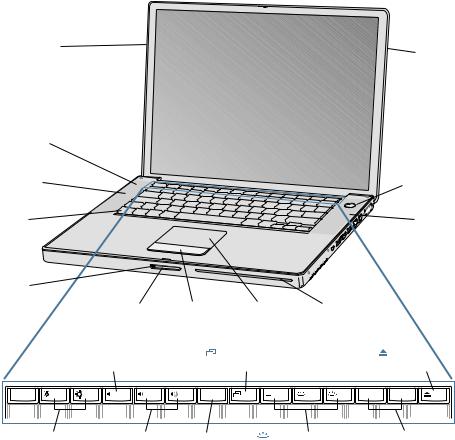
Basic Features of Your PowerBook
AirPort Extreme/
Bluetooth
AirPort Extreme/
antenna window
Bluetooth antenna window
Built-in speaker |
|
|
|
(located under |
|
|
|
speaker grille) |
|
|
|
Microphone |
|
|
® Power button |
|
|
|
® |
Function |
|
|
Built-in speaker |
key (Fn) |
|
|
|
Sleep |
|
|
|
indicator |
|
|
|
light |
|
|
|
Display |
Trackpad |
Trackpad |
Slot-loading |
release button |
button |
|
optical drive |
—Mute |
Video Mode |
Media |
|
control |
Toggle key |
Eject key |
|
esc |
F1 |
F2 |
F3 |
F4 |
F5 |
locknum |
F6 |
F7 |
F8 |
F9 |
F10 |
F11 |
F12 |
¤Brightness |
- Volume |
Num Lock |
Keyboard illumination |
Standard |
controls |
controls |
key |
controls |
function keys |
12 |
Chapter 1 Getting Started |
|
|

¤
—
Brightness controls
Increase or decrease the brightness of your PowerBook display.
Mute control
Mute the volume of the sound coming from the built-in speakers and headphone port.
-Volume controls
Increase or decrease the volume of the sound coming from the speakers and headphone port.
Num Lock key
Activate the numeric keypad embedded in the PowerBook keyboard. When the numeric keypad is activated, a green light glows on the key.
iVideo Mode Toggle key
Switch between dual-display mode (extending your desktop across the built-in and an external display) and video-mirroring mode (presenting the same information on both the built-in and an external display).
oKeyboard illumination controls
Increase (o), decrease (ø), or turn off (O) the brightness of your keyboard illumination.
F11, F12
F11 is preset to open Exposé and F12 opens Dashboard.
CMedia Eject key
Press and hold this key to eject a disc.
Built-in stereo speakers
Listen to music, movies, games, and other multimedia files.
Microphone
Record sounds directly on your hard disk with this microphone (built in under the left speaker grille).
Function (Fn) key
Press and hold to activate customized actions assigned to the function keys (F1 to F12). To learn how to customize function keys, choose Help > Mac Help and search for “function keys.”
Sleep indicator light
A white light pulsates when the PowerBook is in sleep. The light glows steadily for a short time when you start up and shut down your PowerBook.
Display release button
Push to release your display and open your PowerBook.
Trackpad
Move the pointer on the PowerBook display with one finger on the trackpad; scroll with two fingers on the trackpad. See “Using the Trackpad” on page 22 for more information about moving the pointer and scrolling with the trackpad.
Slot-loading optical drive
Your optical drive can read and write to CDs and DVDs. See “Using Your SuperDrive” on page 47 for details.
®Power button
Turn your PowerBook on and off or put it to sleep.
ZAirPort Extreme/Bluetooth antenna window
With an optional AirPort Extreme Base Station, AirPort Express, or other wireless access point, connect to the Internet wirelessly. With Bluetooth® wireless technology, you can wirelessly connect to devices such as mice, keyboards, and cell phones. For more information, see “Understanding AirPort Extreme Wireless Networking” on page 39 and “Using Bluetooth Wireless Technology” on page 40.
Chapter 1 Getting Started |
13 |
|
|
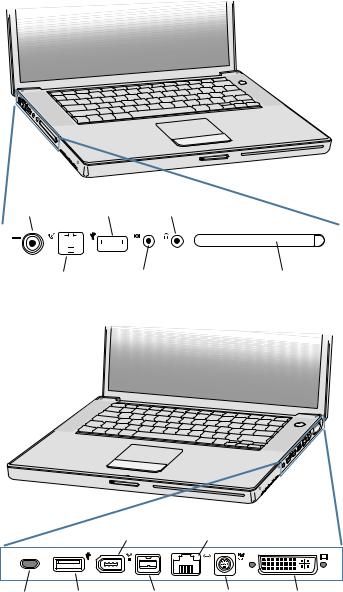
Additional Features of Your PowerBook
®
¯ Power |
d USB 2.0 |
f Headphone/ |
||||||||||||||||
|
|
adapter port |
|
port |
optical digital audio out port |
|||||||||||||
|
|
|
|
|
|
|
|
|
|
|
|
|
|
|
|
|
|
|
|
|
|
|
|
|
|
|
|
|
|
|
|
|
|
|
|
|
|
|
|
|
|
|
|
|
|
|
|
|
|
|
|
|
|
|
|
|
W Internal |
, Audio line in/optical |
PC Card slot |
modem port |
digital audio in port |
|
®
|
H FireWire |
G Gigabit Ethernet port |
|||
|
400 port |
|
(10/100/1000Base-T) |
|
|
Security |
d USB 2.0 port |
H FireWire |
Æ S-video |
£ DVI |
|
slot |
|
|
800 port |
out port |
port |
14 |
Chapter 1 Getting Started |
|
|

¯Power adapter port
Plug in the included power adapter to recharge your PowerBook battery.
WInternal modem port
Connect a standard phone line directly to the internal modem.
dTwo Hi-Speed USB 2.0 (Universal Serial Bus) ports
Connect additional equipment to your PowerBook, such as printers, external storage devices, digital cameras, modems, keyboards, and joysticks. (Compatible with standard USB devices.)
,Audio line in/optical digital audio in port
Connect your PowerBook to a line-level microphone or digital audio equipment.
fHeadphone/optical digital audio out port
Connect external speakers, headphones, or digital audio equipment.
PC Card slot
Expand the capabilities of your PowerBook. Accepts Type I or Type II PC Card and CardBus formats.
Security slot
Protect your PowerBook from theft by connecting a security cable (sold separately).
HTwo FireWire ports
Connect high-speed external devices, such as digital videocameras, and external storage devices. You can connect a standard 6-pin FireWire device directly to the FireWire 400 port, or you can use a 9-to-6-pin FireWire cable to connect the device to the FireWire 800 port. You can also directly connect a 9-pin FireWire device to the FireWire 800 port.
GGigabit Ethernet port (10/100/1000Base-T)
Connect to a high-speed 10/100/1000Base-T Ethernet network or connect to another computer and transfer files. The Ethernet port auto-sensing feature detects other Ethernet devices and doesn’t require an Ethernet crossover cable in order to connect.
ÆTV out (S-video out) port
Connect your PowerBook to a television, VCR, or other video device. You can use the TV out port for presentations or to play a DVD-Video on your television.
£DVI (external monitor) port
Connect to an external monitor or projection device that uses a DVI connector, or use the included DVI-to-VGA adapter to connect a VGA monitor.
For additional information about these features, see Chapter 3,“Using Your PowerBook,” on page 33.
Chapter 1 Getting Started |
15 |
|
|
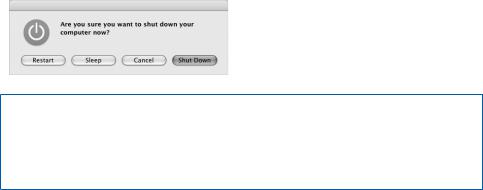
Putting Your PowerBook to Sleep or Shutting It Down
When you finish working with your PowerBook, you can put it to sleep or shut it down.
Putting Your PowerBook to Sleep
If you will be away from your PowerBook for only a short time, put the computer to sleep. When the computer is in sleep, you can quickly wake it and bypass the startup process.
To put the computer to sleep, do one of the following:
mClose the display.
mChoose Apple ( ) > Sleep from the menu bar.
mPress the power button (®) and click Sleep in the dialog that appears.
Warning: Wait a few seconds until the white sleep light on the display latch starts pulsating (indicating that the computer is in sleep and the hard disk has stopped spinning) before you move your PowerBook. Moving your computer while the hard disk is spinning can damage the hard disk, causing loss of data or the inability to start up from the hard disk.
To wake the computer:
ÂIf the display is closed, open it. Your PowerBook automatically wakes from sleep when you open the display.
ÂIf the display is already open, press the power button (®) or any key on the keyboard.
16 |
Chapter 1 Getting Started |
|
|

Shutting Down Your PowerBook
If you aren’t going to use your PowerBook for a day or two, shut it down.
To shut down your computer, do one of the following:
mChoose Apple ( ) > Shut Down from the menu bar.
mPress the power button (®) and click Shut Down in the dialog that appears.
The sleep indicator light goes on briefly during the shutdown process.
If you plan to store your PowerBook for an extended period of time, see “Storing Your PowerBook” on page 74 for information about how to prevent your battery from draining completely.
Calibrating Your Battery
To get the longest running time from your battery, calibrate it sometime during the first week you have your PowerBook and repeat these steps occasionally to keep your battery functioning at its fullest capacity.
To calibrate your battery:
1Plug in the power adapter and fully charge your PowerBook battery until the light on the power adapter plug changes to green and the onscreen meter in the menu bar indicates that the battery is fully charged.
2Allow the battery to rest in the fully charged state for two hours or longer. You may use your computer during this time as long as the adapter is plugged in.
3Disconnect the power adapter with the PowerBook on and start running it from the battery. You may use your computer during this time.
When your battery gets low, you will see the low battery warning dialog on the screen.
4Continue to keep your computer turned on until it goes to sleep. Save all your work and close all applications when the battery gets low and before the system goes to sleep.
5 Turn off the computer or allow it to sleep for five hours or longer.
6Connect the power adapter and leave it connected until the battery is fully charged again.
Important: Repeat the calibration process occasionally to keep your battery fully functioning.
Chapter 1 Getting Started |
17 |
|
|
If you purchased additional batteries, follow the calibration procedure with the additional batteries as well. For more information about your power adapter and battery, see “Using Your Power Adapter” on page 21 and “Using Your Battery” on page 51.
Getting More Information
For more information about your PowerBook, check out these resources:
ÂLearn the important basics about your PowerBook. Check out Chapter 2,“Getting to Know Your PowerBook,” on page 19.
ÂHave fun trying out your computer’s applications and Internet features. Browse the Welcome to Tiger booklet that came with your computer.
ÂIf you’re unfamiliar with Mac OS X, open Mac Help and browse the information there. For more information, see “Getting Answers Using Mac Help” on page 26.
ÂIf you’re having a problem that prevents you from using your computer, see Chapter 5,“Troubleshooting,” on page 63.
ÂCheck out the top ten most commonly asked questions. See Appendix D,“Top Ten Questions,” on page 95.
ÂFor support information, user discussion boards, and the latest Apple software downloads, go to www.apple.com/support.
ÂIf you can’t find the answer to your question in these places, see the AppleCare materials that came with your computer for information about contacting Apple.
18 |
Chapter 1 Getting Started |
|
|

Getting to Know Your PowerBook 2
This chapter introduces important basics about your PowerBook.
Because your PowerBook is so thin and light, you can take it with you to the office, library, class, or wherever you work or play.
Whenever you stop using your PowerBook, wait a few moments to let the hard disk and any optical disc (such as a CD or DVD) in your drive stop spinning before you transport the computer. Avoid jostling or bumping your PowerBook while discs are spinning.
Note: Your PowerBook uses Sudden Motion Sensor technology to help protect the hard disk if the computer is dropped or experiences extreme vibration. See “Understanding Sudden Motion Sensor” on page 51 for more information.
When you use your PowerBook or charge its battery, it is normal for the bottom of the case to get warm. For prolonged use, place your PowerBook on a flat, stable surface. The bottom of the case is raised slightly to allow airflow that keeps the unit within normal operating temperatures.
As you get to know your new PowerBook, you might hear system sounds during startup and when using your hard disk and optical drive. After the PowerBook runs for some time, small fans might turn on to cool it, producing a faint sound. System sounds such as these are part of the computer’s normal functioning.
For more safety instructions about handling and using your PowerBook in different locations, make sure to see Appendix B,“Safety, Use, and Care Information,” on page 73.
19
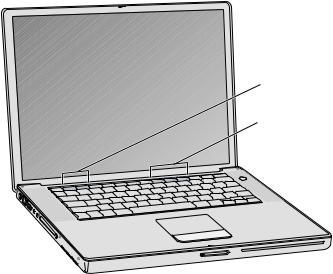
Adjusting Your Display
After you begin working with your new PowerBook, you might need to adjust your display so that the screen is easier to see. Use the keys labeled with the brightness icon (¤) to adjust screen brightness.
¤ Brightness controls


 Keyboard illumination controls
Keyboard illumination controls
®
To turn off the automatic display brightness feature:
mChoose Apple ( ) > System Preferences from the menu bar. Open the Displays pane and deselect the “Automatically adjust brightness as ambient light changes” checkbox.
Changing the Size of Images on the Screen
You can increase or decrease the size of images on your screen by switching from the standard resolution to a scaled resolution. Your PowerBook has a 15.2-inch display with a default resolution of 1440 x 960. You can use other resolutions, such as standard 1024 x 768, as well.
Use a standard resolution when mirroring your screen on an external monitor or when using applications such as games or presentation software designed for a standard resolution.
When you use a standard resolution, a black band appears on each side of the display. If you do not want to see the black bands, you can choose a “stretched” version of the resolution to stretch the image to cover the entire screen and eliminate the black bands.
20 |
Chapter 2 Getting to Know Your PowerBook |
|
|
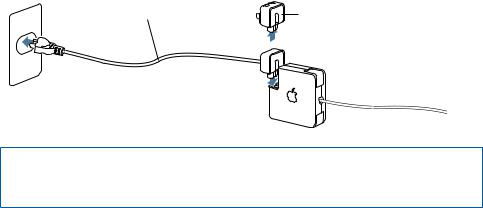
You can choose scaled resolutions in the Displays pane of System Preferences. When you switch to a scaled resolution, items on the screen appear larger, making them easier to see. Scaled resolutions might not be as sharp as the display’s default resolution.
To adjust the resolution on your display:
mChoose Apple ( ) > System Preferences from the menu bar. Open the Displays pane of System Preferences.
To control your display settings using the Displays icon in the menu bar, click “Show displays in menu bar.”
Using Your Power Adapter
Plugging in the power adapter provides AC power to the PowerBook and recharges the computer’s battery.
Important: For optimal performance, use only the power adapter that came with your computer, or purchase an additional 65W Apple Portable Power Adapter.
When you first connect your power adapter to your computer, an indicator light turns on. An amber light indicates that the battery is being charged. A green light indicates that the battery is fully charged. You can monitor the battery level using the Battery icon in the menu bar or by checking the battery level indicator lights on the bottom of the battery (see page 51).
To extend the reach of your power adapter, first pull the AC plug up to remove it from the adapter. Attach the included AC cord to the adapter, and then insert the other end into a wall outlet. The AC cord provides a grounded connection.
AC cord |
AC plug |
Warning: Make sure the power adapter is fully assembled before plugging it in to an electrical outlet. If you’re using the AC plug with your power adapter, make sure the two prongs are in their completely extended position before plugging in the adapter.
Chapter 2 Getting to Know Your PowerBook |
21 |
|
|

For best results, always connect your AC cord and use a grounded outlet when one is available. Use only the AC cord that came with your power adapter. Make sure to push the power plug snugly into the power adapter port on the computer to ensure it is engaged and power is flowing to the computer. If the cord is plugged in properly, you will see an indicator light on the end of the cord that plugs in to your PowerBook.
When disconnecting the power adapter from an outlet or from the computer, pull the plug, not the cord. For safety instructions about using your power adapter, see “Plugging In the Power Adapter” on page 73.
Using the Trackpad
How quickly the pointer moves onscreen is based on how quickly you move your finger across the trackpad. To move the pointer a short distance, move your finger slowly across the trackpad. The faster you move your finger, the farther the pointer moves onscreen.
Tips for Using the Trackpad
For best results when using the trackpad, keep in mind these tips:
ÂUse only one finger, except when the scrolling feature is turned on and you want to scroll.
ÂDo not use a pen or any other object.
ÂKeep your finger and the trackpad dry. If the trackpad becomes moist from humidity or condensation, gently wipe it with a clean cloth before you use it.
ÂNever use any kind of cleaning solution on the trackpad.
For more information about using the trackpad, choose Help > Mac Help from the menu bar at the top of the screen.
Instead of using the trackpad button, you can use your finger to click and double-click directly on the trackpad. You can turn on this feature and other trackpad options in the Keyboard & Mouse pane of System Preferences.
You can also scroll vertically and horizontally in a window that has scroll bars by moving two adjoining fingers on the trackpad. This feature can be turned off or adjusted in the Keyboard & Mouse pane of System Preferences.
Note: If you find that the pointer moves as you type because you accidentally brush the trackpad, you can avoid this problem by selecting the “Ignore accidental trackpad input” option in the Keyboard & Mouse pane of System Preferences.
22 |
Chapter 2 Getting to Know Your PowerBook |
|
|
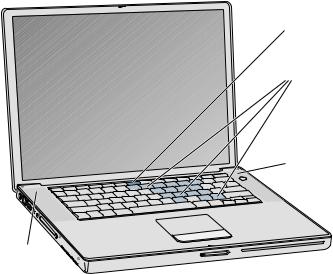
Using the Keyboard
Your PowerBook keyboard has a numeric keypad incorporated in the standard keyboard keys. Keys used for the numeric keypad have a smaller secondary label.
Num Lock key
Numeric keypad
ALS sensor
®
ALS sensor
To use the numeric keypad, press the Num Lock key. The Num Lock key glows green, indicating that the keypad is active. When you finish using the keypad, press the Num Lock key again to turn it off.
Important: If your keyboard doesn’t seem to be working correctly, check the Num Lock key. When the numeric keypad is active, other keys and keyboard equivalents for menu commands (such as x-Q to quit) are deactivated.
Your PowerBook is equipped with an illuminated keyboard and an ambient light-sensing (ALS) system. The ALS sensors are located under the speaker grilles
and will automatically adjust the brightness of your display and keyboard illumination according to the light available in your current environment. You can also adjust the keyboard illumination using the F8, F9, and F10 keys.
Important: Even when the keyboard illumination feature is on, the keyboard illuminates only in low-light situations.
You can turn off the keyboard illumination feature in the Keyboard & Mouse pane of System Preferences or by pressing the F8 key.
Note: Exposé is preset to use the F9 and F10 keys, the same keys that adjust your keyboard illumination. To use Exposé to manage your desktop windows, hold down the Fn key and press F9 or F10, or open the Dashboard & Exposé pane in System Preferences and choose different function keys to manage windows.
Chapter 2 Getting to Know Your PowerBook |
23 |
|
|
If you like to use keyboard shortcuts to work efficiently, choose Help > Mac Help from the menu bar and search for “navigation shortcuts.”You’ll find a list of keyboard shortcuts for many common procedures and applications.
Using a Mouse
If you have an Apple mouse with a USB connection, you can insert the USB connector into the USB 2.0 port and use your mouse right away. If you have an Apple wireless mouse, see “Using Bluetooth Wireless Technology” on page 40 for information about connecting it. You can purchase a wireless or USB mouse from an Apple Authorized Reseller or, if you prefer, from the online Apple Store at www.apple.com/store.
Learning About Mac OS X
Your computer comes with Mac OS X v10.4 “Tiger,” which includes Spotlight, an improved search engine that automatically indexes all of your files; Dashboard, an interface for putting handy “widgets” or mini-applications at your fingertips; Exposé, which tiles and neatly displays all your open applications; and much more.
When you’re ready to learn more about Mac OS X and the award-winning iLife applications that came with your computer, see the Welcome to Tiger booklet that came with your PowerBook. Also open Mac Help by choosing Help > Mac Help from the menu bar at the top of the screen and browse the information there. You’ll find plenty of information for new users, experienced users, and people switching to the Mac. If you experience any problems while using Mac OS X, see Chapter 5,“Troubleshooting,” or Mac Help.
For information about the software applications compatible with Mac OS X or to read more about Mac OS X, check the Apple website at www.apple.com/macosx.
Note: If you want to use Classic applications with your computer, you have to install a version of Mac OS 9 that supports the Classic environment (see “Installing Mac OS 9” on page 68). Mac OS 9 can’t be installed as the primary operating system on your PowerBook, and you can’t start up your computer in Mac OS 9.
24 |
Chapter 2 Getting to Know Your PowerBook |
|
|
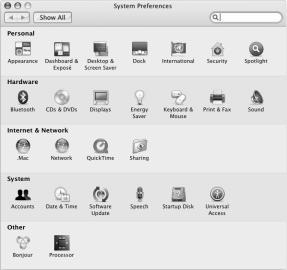
Customizing Your Desktop and Setting Your Preferences
You can quickly make your desktop look the way you want using System Preferences. Choose Apple ( ) > System Preferences from the menu bar.
Feel free to make changes and experiment with the following:
ÂAppearance: Select this preference pane to change the colors of buttons, menus, windows, and highlight colors, among other options.
ÂDashboard & Exposé: Select this preference pane to set active screen corners and shortcuts for Dashboard, the desktop, your application windows, and all windows.
ÂDesktop & Screen Saver: Select this preference pane to change the background color or pattern of your desktop, or change it to a photo or image you like. You can also choose an eye-catching screen effect that will appear on your screen when the computer is left idle.
ÂDock: Select this preference pane to change the look, location, and behavior of your Dock (the bar of icons at the bottom of the screen).
As you get to know your computer, explore the other system preferences. System Preferences is your command center for most settings on your PowerBook. For more information, open Mac Help and search for “System Preferences” or for the specific preference pane you want to change.
Note: Because Apple frequently releases new versions and updates to its system software, applications, and Internet sites, images shown in this book might be slightly different from what you see on your screen.
Chapter 2 Getting to Know Your PowerBook |
25 |
|
|
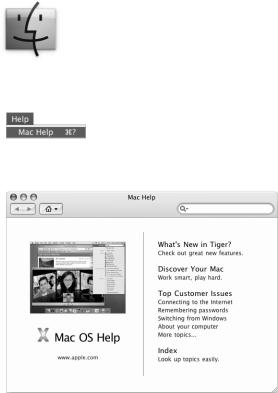
Getting Answers Using Mac Help
Most of the information about using your Macintosh is available right on your computer in Mac Help.
To access Mac Help:
1 Click the Finder icon in the Dock (the bar of icons at the bottom of the screen).
2 Choose Help > Mac Help (click the Help menu in the menu bar and choose Mac Help).
3 Click in the search field, type a question, and press Return on your keyboard.
Using Applications
Your PowerBook comes with software applications for sending email, surfing the Internet, and chatting online. It also includes the iLife suite of applications for activities such as organizing music and digital photos, making movies, and much more. For more information about these applications, see the Welcome to Tiger booklet that came with your computer.
26 |
Chapter 2 Getting to Know Your PowerBook |
|
|
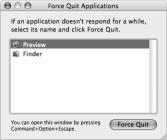
When an Application Does Not Respond
On rare occasions, an application may “freeze” on the screen. Mac OS X provides a way to quit a frozen application without restarting your computer. Quitting a frozen application might allow you to save your work in other open applications.
To force an application to quit:
1Press Command (x)-Option-Esc or choose Apple ( ) > Force Quit from the menu bar. The Force Quit Applications dialog appears with the application selected.
2Click Force Quit.
The application quits, leaving all other applications open.
If you need to, you can also force the Classic environment to quit, which closes all Classic applications. You can also restart the Finder from this dialog.
If you’re experiencing other problems with an application, see Chapter 5, “Troubleshooting,” on page 63.
Connecting to a Network
If you want to connect your PowerBook to an Ethernet network or a wireless network, see “Connecting With Ethernet (10/100/1000Base-T)” on page 43 and “Understanding AirPort Extreme Wireless Networking” on page 39 for more information about setting up an Ethernet or AirPort connection. Also open Mac Help and search for “Ethernet” or “AirPort” for further help.
Using the Internet
During the initial setup, you learned how to connect to the Internet. If you need to change to a different type of connection, such as DSL, cable modem, Ethernet local area network (LAN), or AirPort Extreme network, you can find more information in Appendix C,“Connecting to the Internet,” on page 79.
Chapter 2 Getting to Know Your PowerBook |
27 |
|
|
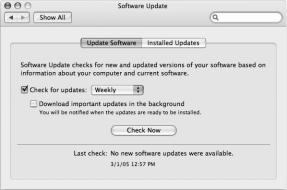
Keeping Your Software Up to Date
You can connect to the Internet and automatically download and install the latest free software versions, drivers, and other enhancements from Apple.
When you are connected to the Internet, Software Update checks Apple’s Internet servers to see if any updates are available for your computer. You can set your Mac to check the Apple server periodically and download and install updated software.
To check for updated software: 1 Open System Preferences.
2 Click the Software Update icon and follow the directions on the screen.
ÂFor more information, search for “Software Update” in Mac Help.
ÂFor the latest information about Mac OS X, go to the Mac OS X website at www.apple.com/macosx.
Connecting to a Printer
Follow the instructions that came with your printer to install the required software and connect the printer. The drivers for most printers are built in to Mac OS X.
You can connect many printers with a USB cable; others require a network connection, such as Ethernet. If you have an AirPort Express or AirPort Extreme Base Station, you can connect a USB printer to the base station (instead of connecting it to your computer) and print wirelessly. For more information about your USB ports, see “Using Universal Serial Bus (USB) Devices” on page 34. For more information about a wireless or network connection, see “Understanding AirPort Extreme Wireless Networking” on page 39 and “Connecting With Ethernet (10/100/1000Base-T)” on page 43.
28 |
Chapter 2 Getting to Know Your PowerBook |
|
|
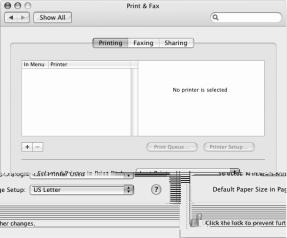
After you connect a USB or FireWire printer, your computer usually detects it automatically and adds it to the list of available printers. You might need to know the network name or address of printers connected to a network before you can print to them. Use the Print & Fax pane of System Preferences to select your printer.
To set up a printer:
1 Open System Preferences and click the Print & Fax icon.
2 Click Printing and then click the Add button (+) to add a printer.
3 Select the printer you want to use, and then click Add.
4Use the Add button (+) and Remove button (–) to choose the printers that appear in the printer list.
Monitoring Printing
After you send a document to a printer, you can monitor printing, including deleting your print job or putting it temporarily on hold. Click the printer icon in the Dock to open the Printer window. For more information, choose Help > Mac Help and search for “printing.”
Chapter 2 Getting to Know Your PowerBook |
29 |
|
|

Playing a CD and Connecting Headphones
You can use iTunes, an easy-to-use music player, to listen to your iTunes music and CDs while you work. Insert a music CD in your optical drive and iTunes appears automatically on the screen. You can listen to your music on the PowerBook internal speakers or connect headphones with a minijack to the headphone port of your PowerBook for private listening right away.
To learn more about iTunes:
mOpen iTunes and choose Help >” iTunes and Music Store Help.”
Warning: Listening to audio at high volume over extended periods of time can damage your hearing.
Connecting a Camera or Other FireWire or USB Device
If you have an iPod, iSight camera, digital camera, videocamera, scanner, or other device that has a USB or FireWire connector, you can connect it to your PowerBook. Follow the installation instructions that came with your device. For more information about FireWire, see “Connecting With FireWire” on page 36. For more information about USB, see “Using Universal Serial Bus (USB) Devices” on page 34.
Transferring Files to Another Computer
If you want to transfer files or documents to or from your PowerBook, there are several ways of doing it.
ÂYou can easily transfer files using Migration Assistant and a FireWire cable (sold separately). You can also connect to another Mac using a FireWire cable and start up your PowerBook G4 in FireWire Target Disk Mode. Your PowerBook appears as a hard disk on the other computer and you can drag files to it. For information about using FireWire to transfer files, see “Connecting Your PowerBook to Another Computer Using FireWire” on page 37.
ÂIf you have an external hard disk drive, flash drive, Zip drive, or other data storage device that connects through a USB or FireWire cable, you can use it to transfer files.
ÂIf you have an email connection, you can email your files to another computer.
ÂIf you register for a .Mac account from Apple (fees apply), you can use it to transfer files. With a .Mac account, you get an iDisk, which provides Internet space for backing up and storing files so that other computers can access the files you transfer there.
ÂIf the other computer has a recordable optical drive, you can transfer files that you have recorded on a CD or DVD disc.
30 |
Chapter 2 Getting to Know Your PowerBook |
|
|
